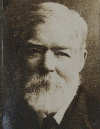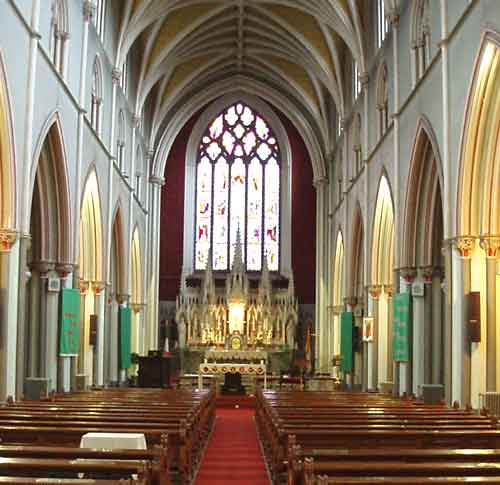
Christopher Burgess
(1845 -1928)
Birth
Christopher Burgess was born in Co. Wicklow around 1845. He appears to have come to Dublin with his parents and was living with them in Thomas Street at the time of his marriage. His address and that of his father, John, and mother, Sara, is shown on his church marriage cert as Thomas St. but no street number is given. There was a John Burgess (his father's name) listed as head of household at 3 Thomas St. in the 1851 census of population. Unfortunately, only the index remains and it is not possible to see who lived in the house. For the moment, I am taking it that the family came to town prior to 1851 and lodged in 3 James's St.
Marriage
In 1886 he married Sarah Rankin and had at least 11 children. Regarding the marriage there is a "Ter" dispensation recorded in the church marriage certificate indicating that they were second cousins. Christopher's age is given as 21, so he would not have needed the consent of his parents to marry the (illiterate) servant girl. She was only 20 and would have needed the consent of her parents to marry the (budding) shoemaker. Without such consent she would have had to get a dispensation which would have to be recorded and there is no such record. So we can assume that her parents, at least, were happy with the marriage. The ceremony took place in the Pro-Cathedral as this was Sarah's parish. She was in service to John Barrington, 202 Great Britain St.. John became a Sir in the year of her marriage, having entertained the Prince of Wales in Dublin the previous year when he was Lord Mayor of Dublin. The house is now part of the Parnell Centre where Stringfellow recently failed to grab a share of the Dublin sex-club market.
Sarah Rankin died in 1906 and Christopher donated two vases to St. James's RC church in her memory. I hope to get a photo of these in due course, but in the meantime here is a photo of the very impressive interior of St. James's church with which Christopher was associated over the years.

Career
Between 1867and 1873, when he came to James's Street, he appears to have been apprenticed to John Dowling's shoemakers in Wood Quay. John Dowling is listed as the ratepayer. At this time 15 of the Quay's 22 premises housed shoemakers.
Most of Christopher's shoe/boot making career was spent as a proprietor in James's Street, but at different addresses. Among his clients was the British Military.
1918 was a rough year for Christopher. His daughter Bridget, who had married Nicholas Fleming, the cooper, had died. His son-in-law, Patrick Mortimer, had drowned. His (disinherited) son, John, had been invalided out of the British Army on the Somme and had returned home to unemployment in Dublin. The previous year his firstborn, unmarried daughter, had been admitted to St. Ita's psychiatric hospital in Portrane (on 18 June 1917, where she was to stay until her death in 1948). He was left with himself and his two unmarried daughters in No. 45 James's St. and with no one to continue the business. In fact he had had no one to carry on the business since John left to join the British Army in [end 1914-1915?]. And Christopher was now 73 years of age.
It should, therefore, be no wonder that he "retired" in this year. The last entry for him as tenant of 45 James's St. in Thom's is in the 1919 edition which would have related to the situation in 1918 at the latest.
By 1919 [Thom's 1920 edition] he had left "the Street" and moved to Donore Cottage where the three of them ran a shop at Parnell Bridge (known as locally as Sally bridge!).
Will
He made a will on 12 June 1919 in which he left all his property to the two unmarried daughters, " my other daughters having already been provided for". No doubt this reference referred to dowries in the cases of those daughters who married, and possibly an assisted passage for another daughter who had emigrated to Canada. It is not clear what provision was involved in the case of the daughter who entered St. Itas. And there might have been some further provision in the case of my Granny after her husband's untimely death in 1918. Christopher lists 48 James's St. as his residence at the time he made the will and Granny's papers suggest that she (and her 4 children) were living at this address at the time. Presumably the two unmarried daughters were also in residence. That must have been some household.
Death
In any event, Christopher died in Donore Cottage in 1928 of gout, bronchitis, and cardiac failure. His death was reported by Tess Medlar (n�e Burgess) who was present at the death. The newspaper death notice can be seen here . The only point to note is that the funeral was private. I don't know what the significance of this is.
At that stage his estate was worth �438-7s-3d. - possibly the value of the house which he may have owned. In 2003 values (related purely to the trend of the Consumer Price Index) this would have been worth about �20,000. Clearly the value of the house itself today would be something else.
He is buried in Glasnevin under the celtic cross he erected to commemorate his wife's death in 1906. Occupants of the grave are, for the most part, unsurprising: himself and his wife, Margaret [St. Ita's], Catherine and Christina [Donore Cottage]. However, one of his married daughters, Lil [died 1957] along with her husband Andy Duffy [died 1923] are also in residence. I wonder if, in the "absence" of his own two sons - Christopher Joseph who emigrated and John whom he disinherited, he took to Andy Duffy as a sort of substitute son.
The business at 45 James's St. continued as a shoemaker's after he left. It was run by P J Brennan up to around 1940 and subsequently by M Brell. I haven't so far checked any later dates for subsequent change of use.
Outstanding Questions
- Did Christopher come to Dublin with his family (father) shortly after his birth in 1845[?] and live at 3 Thomas St.
- Were Christopher and Sarah Rankin 2nd cousins?
- Was Christopher originally planning to retire in 1919 and leave the business, with the military contract, to John.
- After John's defection, did Christopher take to Andy Duffy as a substitute son and is that why Andy is buried in the family grave in Glasnevin. How would Christopher Joseph, his other son, fit into this scenario. He appears to have been around until 1919, at least. Perhaps he emigrated in that year or very shortly after.
- Why was the funeral private.